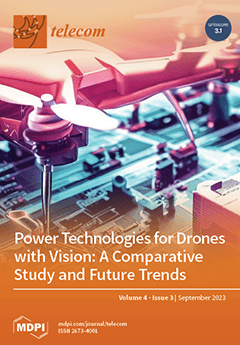Traditional networking is hardware-based, having the control plane coupled with the data plane. Software-Defined Networking (SDN), which has a logically centralized control plane, has been introduced to increase the programmability and flexibility of networks. Knowledge-Defined Networking (KDN) is an advanced version of SDN
[...] Read more.
Traditional networking is hardware-based, having the control plane coupled with the data plane. Software-Defined Networking (SDN), which has a logically centralized control plane, has been introduced to increase the programmability and flexibility of networks. Knowledge-Defined Networking (KDN) is an advanced version of SDN that takes one step forward by decoupling the management plane from control logic and introducing a new plane, called a knowledge plane, decoupled from control logic for generating knowledge based on data collected from the network. KDN is the next-generation architecture for self-learning, self-organizing, and self-evolving networks with high automation and intelligence. Even though KDN was introduced about two decades ago, it had not gained much attention among researchers until recently. The reasons for delayed recognition could be due to the technology gap and difficulty in direct transformation from traditional networks to KDN. Communication networks around the globe have already begun to transform from SDNs into KDNs. Machine learning models are typically used to generate knowledge using the data collected from network devices and sensors, where the generated knowledge may be further composed to create knowledge ontologies that can be used in generating rules, where rules and/or knowledge can be provided to the control, management, and application planes for use in decision-making processes, for network monitoring and configuration, and for dynamic adjustment of network policies, respectively. Among the numerous advantages that KDN brings compared to SDN, enhanced automation and intelligence, higher flexibility, and improved security stand tall. However, KDN also has a set of challenges, such as reliance on large quantities of high-quality data, difficulty in integration with legacy networks, the high cost of upgrading to KDN, etc. In this survey, we first present an overview of the KDN architecture and then discuss each plane of the KDN in detail, such as sub-planes and interfaces, functions of each plane, existing standards and protocols, different models of the planes, etc., with respect to examples from the existing literature. Existing works are qualitatively reviewed and assessed by grouping them into categories and assessing the individual performance of the literature where possible. We further compare and contrast traditional networks and SDN against KDN. Finally, we discuss the benefits, challenges, design guidelines, and ongoing research of KDNs. Design guidelines and recommendations are provided so that identified challenges can be mitigated. Therefore, this survey is a comprehensive review of architecture, operation, applications, and existing works of knowledge-defined networks.
Full article





